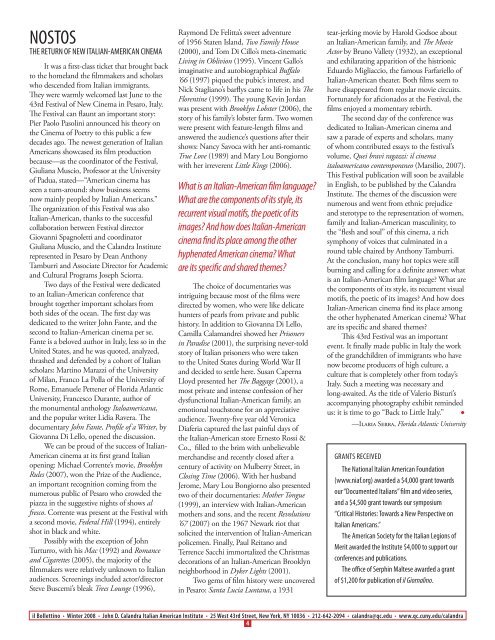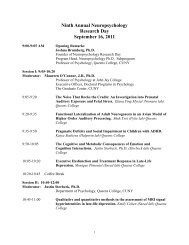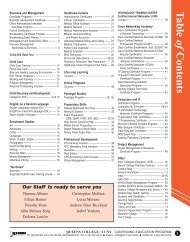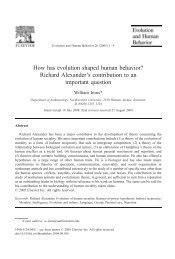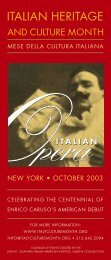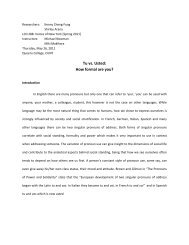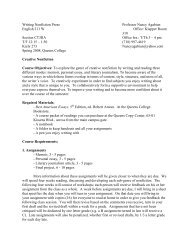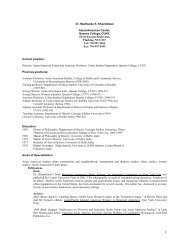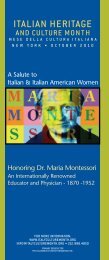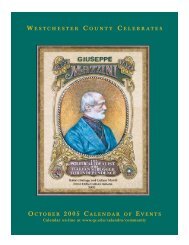CAlANDRA ITAlIAN AMeRICAN INsTITUTe - CUNY
CAlANDRA ITAlIAN AMeRICAN INsTITUTe - CUNY
CAlANDRA ITAlIAN AMeRICAN INsTITUTe - CUNY
You also want an ePaper? Increase the reach of your titles
YUMPU automatically turns print PDFs into web optimized ePapers that Google loves.
Nostos<br />
The Return of New Italian-American Cinema<br />
It was a first-class ticket that brought back<br />
to the homeland the filmmakers and scholars<br />
who descended from Italian immigrants.<br />
They were warmly welcomed last June to the<br />
43rd Festival of New Cinema in Pesaro, Italy.<br />
The Festival can flaunt an important story:<br />
Pier Paolo Pasolini announced his theory on<br />
the Cinema of Poetry to this public a few<br />
decades ago. The newest generation of Italian<br />
Americans showcased its film production<br />
because—as the coordinator of the Festival,<br />
Giuliana Muscio, Professor at the University<br />
of Padua, stated—“American cinema has<br />
seen a turn-around: show business seems<br />
now mainly peopled by Italian Americans.”<br />
The organization of this Festival was also<br />
Italian-American, thanks to the successful<br />
collaboration between Festival director<br />
Giovanni Spagnoletti and coordinator<br />
Giuliana Muscio, and the Calandra Institute<br />
represented in Pesaro by Dean Anthony<br />
Tamburri and Associate Director for Academic<br />
and Cultural Programs Joseph Sciorra.<br />
Two days of the Festival were dedicated<br />
to an Italian-American conference that<br />
brought together important scholars from<br />
both sides of the ocean. The first day was<br />
dedicated to the writer John Fante, and the<br />
second to Italian-American cinema per se.<br />
Fante is a beloved author in Italy, less so in the<br />
United States, and he was quoted, analyzed,<br />
thrashed and defended by a cohort of Italian<br />
scholars: Martino Marazzi of the University<br />
of Milan, Franco La Polla of the University of<br />
Rome, Emanuele Pettener of Florida Atlantic<br />
University, Francesco Durante, author of<br />
the monumental anthology Italoamericana,<br />
and the popular writer Lidia Ravera. The<br />
documentary John Fante, Profile of a Writer, by<br />
Giovanna Di Lello, opened the discussion.<br />
We can be proud of the success of Italian-<br />
American cinema at its first grand Italian<br />
opening: Michael Corrente’s movie, Brooklyn<br />
Rules (2007), won the Prize of the Audience,<br />
an important recognition coming from the<br />
numerous public of Pesaro who crowded the<br />
piazza in the suggestive nights of shows al<br />
fresco. Corrente was present at the Festival with<br />
a second movie, Federal Hill (1994), entirely<br />
shot in black and white.<br />
Possibly with the exception of John<br />
Turturro, with his Mac (1992) and Romance<br />
and Cigarettes (2005), the majority of the<br />
filmmakers were relatively unknown to Italian<br />
audiences. Screenings included actor/director<br />
Steve Buscemi’s bleak Trees Lounge (1996),<br />
Raymond De Felitta’s sweet adventure<br />
of 1956 Staten Island, Two Family House<br />
(2000), and Tom Di Cillo’s meta-cinematic<br />
Living in Oblivion (1995). Vincent Gallo’s<br />
imaginative and autobiographical Buffalo<br />
’66 (1997) piqued the pubic’s interest, and<br />
Nick Stagliano’s barflys came to life in his The<br />
Florentine (1999). The young Kevin Jordan<br />
was present with Brooklyn Lobster (2006), the<br />
story of his family’s lobster farm. Two women<br />
were present with feature-length films and<br />
answered the audience’s questions after their<br />
shows: Nancy Savoca with her anti-romantic<br />
True Love (1989) and Mary Lou Bongiorno<br />
with her irreverent Little Kings (2006).<br />
What is an Italian-American film language?<br />
What are the components of its style, its<br />
recurrent visual motifs, the poetic of its<br />
images? And how does Italian-American<br />
cinema find its place among the other<br />
hyphenated American cinema? What<br />
are its specific and shared themes?<br />
The choice of documentaries was<br />
intriguing because most of the films were<br />
directed by women, who were like delicate<br />
hunters of pearls from private and public<br />
history. In addition to Giovanna Di Lello,<br />
Camilla Calamandrei showed her Prisoners<br />
in Paradise (2001), the surprising never-told<br />
story of Italian prisoners who were taken<br />
to the United States during World War II<br />
and decided to settle here. Susan Caperna<br />
Lloyd presented her The Baggage (2001), a<br />
most private and intense confession of her<br />
dysfunctional Italian-American family, an<br />
emotional touchstone for an appreciative<br />
audience. Twenty-five year old Veronica<br />
Diaferia captured the last painful days of<br />
the Italian-American store Ernesto Rossi &<br />
Co., filled to the brim with unbelievable<br />
merchandise and recently closed after a<br />
century of activity on Mulberry Street, in<br />
Closing Time (2006). With her husband<br />
Jerome, Mary Lou Bongiorno also presented<br />
two of their documentaries: Mother Tongue<br />
(1999), an interview with Italian-American<br />
mothers and sons, and the recent Revolutions<br />
’67 (2007) on the 1967 Newark riot that<br />
solicited the intervention of Italian-American<br />
policemen. Finally, Paul Reitano and<br />
Terrence Sacchi immortalized the Christmas<br />
decorations of an Italian-American Brooklyn<br />
neighborhood in Dyker Lights (2001).<br />
Two gems of film history were uncovered<br />
in Pesaro: Santa Lucia Luntana, a 1931<br />
tear-jerking movie by Harold Godsoe about<br />
an Italian-American family, and The Movie<br />
Actor by Bruno Vallety (1932), an exceptional<br />
and exhilarating apparition of the histrionic<br />
Eduardo Migliaccio, the famous Farfariello of<br />
Italian-American theater. Both films seem to<br />
have disappeared from regular movie circuits.<br />
Fortunately for aficionados at the Festival, the<br />
films enjoyed a momentary rebirth.<br />
The second day of the conference was<br />
dedicated to Italian-American cinema and<br />
saw a parade of experts and scholars, many<br />
of whom contributed essays to the festival’s<br />
volume, Quei bravi ragazzi: il cinema<br />
italoamericano contemporaneo (Marsilio, 2007).<br />
This Festival publication will soon be available<br />
in English, to be published by the Calandra<br />
Institute. The themes of the discussion were<br />
numerous and went from ethnic prejudice<br />
and sterotype to the representation of women,<br />
family and Italian-American masculinity, to<br />
the “flesh and soul” of this cinema, a rich<br />
symphony of voices that culminated in a<br />
round table chaired by Anthony Tamburri.<br />
At the conclusion, many hot topics were still<br />
burning and calling for a definite answer: what<br />
is an Italian-American film language? What are<br />
the components of its style, its recurrent visual<br />
motifs, the poetic of its images? And how does<br />
Italian-American cinema find its place among<br />
the other hyphenated American cinema? What<br />
are its specific and shared themes?<br />
This 43rd Festival was an important<br />
event. It finally made public in Italy the work<br />
of the grandchildren of immigrants who have<br />
now become producers of high culture, a<br />
culture that is completely other from today’s<br />
Italy. Such a meeting was necessary and<br />
long-awaited. As the title of Valerio Bisturi’s<br />
accompanying photography exhibit reminded<br />
us: it is time to go “Back to Little Italy.” •<br />
—Ilaria Serra, Florida Atlantic University<br />
Grants Received<br />
The National Italian American Foundation<br />
(www.niaf.org) awarded a $4,000 grant towards<br />
our “Documented Italians” film and video series,<br />
and a $4,500 grant towards our symposium<br />
“Critical Histories: Towards a New Perspective on<br />
Italian Americans.”<br />
The American Society for the Italian Legions of<br />
Merit awarded the Institute $4,000 to support our<br />
conferences and publications.<br />
The office of Serphin Maltese awarded a grant<br />
of $1,200 for publication of il Giornalino.<br />
il Bollettino • Winter 2008 • John D. Calandra Italian American Institute • 25 West 43rd Street, New York, NY 10036 • 212-642-2094 • calandra@qc.edu • www.qc.cuny.edu/calandra<br />
4


